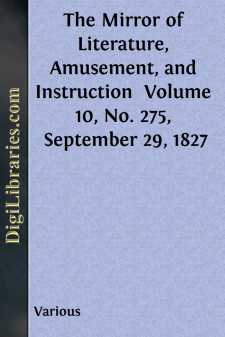Categories
- Antiques & Collectibles 13
- Architecture 36
- Art 48
- Bibles 22
- Biography & Autobiography 813
- Body, Mind & Spirit 142
- Business & Economics 28
- Children's Books 17
- Children's Fiction 14
- Computers 4
- Cooking 94
- Crafts & Hobbies 4
- Drama 346
- Education 46
- Family & Relationships 57
- Fiction 11829
- Games 19
- Gardening 17
- Health & Fitness 34
- History 1377
- House & Home 1
- Humor 147
- Juvenile Fiction 1873
- Juvenile Nonfiction 202
- Language Arts & Disciplines 88
- Law 16
- Literary Collections 686
- Literary Criticism 179
- Mathematics 13
- Medical 41
- Music 40
- Nature 179
- Non-Classifiable 1768
- Performing Arts 7
- Periodicals 1453
- Philosophy 64
- Photography 2
- Poetry 896
- Political Science 203
- Psychology 42
- Reference 154
- Religion 513
- Science 126
- Self-Help 84
- Social Science 81
- Sports & Recreation 34
- Study Aids 3
- Technology & Engineering 59
- Transportation 23
- Travel 463
- True Crime 29
The Mirror of Literature, Amusement, and Instruction Volume 10, No. 275, September 29, 1827
by: Various
Categories:
Description:
Excerpt
KEW PALACE.
Innumerable are the instances of princes having sought to perpetuate their memories by the building of palaces, from the Domus Aurea, or golden house of Nero, to the comparatively puny structures of our own times. As specimens of modern magnificence and substantial comfort, the latter class of edifices may be admirable; but we are bound to acknowledge, that in boldness and splendour of design, they cannot assimilate to the labours of antiquity, much of whose stupendous character is to this day preserved in many series of interesting ruins:—
Whilst in the progress of the long decay,
Thrones sink to dust, and nations pass away.
As a record of this degeneracy, near the western corner of Kew Green stands the new palace, commenced for George III., under the direction of the late James Wyatt, Esq. The north front, the only part open to public inspection, possesses an air of solemn, sullen grandeur; but it very ill accords with the taste and science generally displayed by its nominal architect.
To quote the words of a contemporary, "this Anglo-Teutonic, castellated, gothized structure must be considered as an abortive production, at once illustrative of bad taste and defective judgment. From the small size of the windows and the diminutive proportion of its turrets, it would seem to possess
"'Windows that exclude the light,
And passages that lead to nothing.'"
Upon the unhappy seclusion of the royal architect, the works were suspended, and it now remains unfinished. Censure and abuse have, however, always been abundantly lavished on its architecture, whether it be the result of royal caprice or of professional study; but the taste of either party deserves to be taxed with its demerits.
The northern front was intended to be appropriated to the use of domestics; the whole building is rendered nearly indestructible by fire, by means of cast-iron joists and rafters, &c., certainly in this case an unnecessary precaution, since the whole pile is shortly to be pulled down. The foundation, too, is in a bog close to the Thames, and the principal object in its view is the dirty town of Brentford, on the opposite side of the river; a selection, it would seem, of family taste, for George II. is known to have often said, when riding through Brentford, "I do like this place, it's so like Yarmany."
A modern tourist, in "A Morning's Walk from London to Kew," characterizes the new palace as "the Bastile palace, from its resemblance to that building, so obnoxious to freedom and freemen. On a former occasion," says he, "I have viewed its interior, and I am at a loss to conceive the motive for preferring an external form, which rendered it impracticable to construct within it more than a series of large closets, boudoirs, and rooms like oratories." The latter part of this censure is judiciously correct; but the epithet "bastile" is perhaps too harsh for some ears.
The old palace at Kew formerly belonged to the Capel family, and by marriage became the property of Samuel Molyneux, Esq., secretary to George II....












